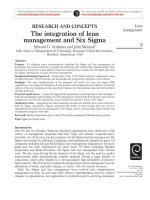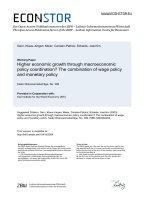The architecture of computer hardware and systems software an information technology approach ch04
Bạn đang xem bản rút gọn của tài liệu. Xem và tải ngay bản đầy đủ của tài liệu tại đây (236.77 KB, 34 trang )
CHAPTER 4:
Representing Integer Data
The Architecture of Computer Hardware
and Systems Software:
An Information Technology Approach
3rd Edition, Irv Englander
John Wiley and Sons
2003
Number Representation
Numbers can be represented as a
combination of
Value or magnitude
Sign (plus or minus)
Chapter 4 Representing
Integer Data
4-2
32-bit Data Word
Chapter 4 Representing
Integer Data
4-3
Unsigned Numbers: Integers
Unsigned whole number or integer
Direct binary equivalent of decimal integer
4 bits: 0 to 9
16 bits: 0 to 9,999
8 bits: 0 to 99
32 bits: 0 to 99,999,999
Decimal
Binary
BCD
= 0100 0100
= 0110
1000
= 26 + 22 = 64 + 4 = 68
= 22 + 2 1 = 6
23 = 8
99
(largest 8-bit
BCD)
= 0110 0011
= 1001
1001
= 2 6 + 2 5 + 2 1 + 20 =
= 64 + 32 + 2 + 1 = 99
= 23 + 2 0
=
9
23 + 2 0
9
255
(largest 8-bit
binary)
= 1111 1111
= 0010
= 28 – 1 = 255
= 21
= 2
68
Chapter 4 Representing
Integer Data
0101
22 + 20
5
4-4
0101
22 + 20
5
Value Range: Binary vs. BCD
BCD range of values < conventional binary
representation
Binary: 4 bits can hold 16 different values (0 to 15)
BCD: 4 bits can hold only 10 different values (0 to 9)
No. of Bits
BCD Range
Binary Range
4
0-9
1 digit
0-15
1+ digit
8
0-99
2 digits
0-255
2+ digits
12
0-999
3 digits
0-4,095
3+ digits
16
0-9,999
4 digits
0-65,535
4+ digits
20
0-99,999
5 digits
0-1 million
6 digits
24
0-999,999
6 digits
0-16 million
7+ digits
32
0-99,999,999
8 digits
0-4 billion
9+ digits
64
0-(1016-1)
16 digits
0-16 quintillion
19+ digits
Chapter 4 Representing
Integer Data
4-5
Conventional Binary vs. BCD
Binary representation generally
preferred
Greater range of value for given number of
bits
Calculations easier
BCD often used in business
applications to maintain decimal
rounding and decimal precision
Chapter 4 Representing
Integer Data
4-6
Simple BCD Multiplication
Chapter 4 Representing
Integer Data
4-7
Signed-Integer Representation
No obvious direct way to represent the
sign in binary notation
Options:
Sign-and-magnitude representation
1’s complement
2’s complement (most common)
Chapter 4 Representing
Integer Data
4-8
Sign-and-Magnitude
Use left-most bit for sign
0 = plus; 1 = minus
Total range of integers the same
Half of integers positive; half negative
Magnitude of largest integer half as large
Example using 8 bits:
Unsigned: 1111 1111 = +255
Signed: 0111 1111 = +127
1111 1111 = -127
Note: 2 values for 0:
+0 (0000 0000) and -0 (1000 0000)
Chapter 4 Representing
Integer Data
4-9
Difficult Calculation Algorithms
Sign-and-magnitude algorithms complex and difficult to
implement in hardware
Must test for 2 values of 0
Useful with BCD
Order of signed number and carry/borrow makes a difference
Example: Decimal addition algorithm
Addition:
2 Positive Numbers
4
+2
6
Chapter 4 Representing
Integer Data
Addition:
1 Signed Number
4
-2
2
2
-4
-2
4-10
12
-4
8
Complementary Representation
Sign of the number does not have to be
handled separately
Consistent for all different signed
combinations of input numbers
Two methods
Radix: value used is the base number
Diminished radix: value used is the base number
minus 1
9’s complement: base 10 diminished radix
1’s complement: base 2 diminished radix
Chapter 4 Representing
Integer Data
4-11
9’s Decimal Complement
Taking the complement: subtracting a value from a standard
basis value
Decimal (base 10) system diminished radix complement
Radix minus 1 = 10 – 1
9 as the basis
3-digit example: base value = 999
Range of possible values 0 to 999 arbitrarily split at 500
Numbers
Representation method
Range of decimal numbers
Calculation
Positive
Complement
Number itself
-499
-000
+0
999 minus number
Representation example
999 – 499
Chapter 4 Representing
Integer Data
Negative
500
–
499
none
999
0
Increasing value
4-12
499
+
9’s Decimal Complement
Necessary to specify number of digits or word
size
Example: representation of 3-digit number
First digit = 0 through 4
First digit = 5 through 9
positive number
negative number
Conversion to sign-and-magnitude number for
9’s complement
321 remains 321
521: take the complement (999 – 521) = – 478
Chapter 4 Representing
Integer Data
4-13
Modular Arithmetic
Find the remainder of integer division
Example:
4 mod 4 = 0
5 mod 4 = 1
1000 mod 999 = 1
Most important characteristic of modular
arithmetic
Count repeats from 0 when limit or modulus
exceeded
Chapter 4 Representing
Integer Data
4-14
Choice of Representation
Must be consistent with rules of normal
arithmetic
- (-value) = value
If we complement the value twice, it
should return to its original value
Complement = basis – value
Complement twice
Basis – (basis – value) = value
Chapter 4 Representing
Integer Data
4-15
Modular Addition
Counting upward on scale corresponds to addition
Example in 9’s complement: does not cross the
modulus
+250
Representation
Number
represented
+250
500
649
899
999
0
170
420
499
-499
-350
-100
-000
0
170
420
499
Chapter 4 Representing
Integer Data
+250
+250
4-16
Addition with Wraparound
Count to the right to add a negative number
Wraparound scale used to extend the range for the
negative result
Counting left would cross the modulus and give incorrect
answer because there are 2 values for 0 (+0 and -0)
+699
Representation
Number
represented
500
999
0
200
499
-499 -000
0
200
499
Number
represented
Chapter 4 Representing
Integer Data
899
999
-499 -100 -000
-300
Wrong Answer!!
Representation
500
+699
500
898
999
0
200
499
-499
-101
-000
0
200
499
- 300
4-17
Addition with End-around Carry
Count to the right crosses the modulus
End-around carry
Add 2 numbers in 9’s complementary arithmetic
If the result has more digits than specified, add carry
to the result
+300
Representation
Number
represented
500
799
999
0
-499 -200 -000
0
(1099)
99
499
100
499
+300
799
300
1099
1
Chapter 4 Representing
Integer Data
4-18
100
Overflow
Fixed word size has a fixed range size
Overflow: combination of numbers that adds
to result outside the range
End-around carry in modular arithmetic avoids
problem
Complementary arithmetic: numbers out of
range have the opposite sign
Test: If both inputs to an addition have the same
sign and the output sign is different, an overflow
occurred
Chapter 4 Representing
Integer Data
4-19
1’s Binary Complement
Taking the complement: subtracting a value from a standard basis
value
Binary (base 2) system diminished radix complement
Radix minus 1 = 2 – 1
1 as the basis
Inversion: change 1’s to 0’s and 0’s to 1s
Numbers beginning with 0 are positive
Numbers beginning with 1 are negative
2 values for zero
Example with 8-bit binary numbers
Numbers
Representation method
Range of decimal numbers
Calculation
Representation example
Chapter 4 Representing
Integer Data
Negative
Positive
Complement
Number itself
-12710
-010
+010
Inversion
10000000
11111111
12710
None
00000000
4-20
01111111
Conversion between
Complementary Forms
Cannot convert directly between 9’s
complement and 1’s complement
Modulus in 3-digit decimal: 999
Positive range 499
Modulus in 8-bit binary:
11111111 or 25510
Positive range 01111111 or 12710
Intermediate step: sign-and-magnitude
representation
Chapter 4 Representing
Integer Data
4-21
Addition
Add 2 positive 8-bit
numbers
Add 2 8-bit numbers
with different signs
0010 1101 =
45
0011 1010 =
0110 0111 =
58
103
0010 1101 =
1100 0101 =
1111 0010 =
45
–58
–13
Take the 1’s
complement of 58
(i.e., invert)
0011 1010
0000 1101
Invert to get
1100 0101
magnitude
8+4+1 =
Chapter 4 Representing
Integer Data
4-22
13
Addition with Carry
8-bit number
Invert
0000 0010 (210)
1111 1101
Add
9 bits
End-around carry
Chapter 4 Representing
Integer Data
0110 1010 =
1111 1101 =
10110 0111
+1
0110 1000 =
4-23
106
–2
104
Subtraction
8-bit number
Invert
0101 1010 (9010)
1010 0101
Add
9 bits
End-around carry
0110 1010 =
106
-0101 1010 =
90
0110 1010 =
106
–1010 0101 =
90
10000 1111
+1
0001 0000 =
Chapter 4 Representing
Integer Data
4-24
16
Overflow
8-bit number
256 different numbers
Positive numbers:
0 to 127
Add
Test for overflow
2 positive inputs
produced negative
result
overflow!
Wrong answer!
0100 0000 =
64
0100 0001 =
65
1000 0001
-126
0111 1110
Invert to get
magnitude
12610
Programmers beware: some high-level
languages, e.g., some versions of BASIC, do
not check for overflow adequately
Chapter 4 Representing
Integer Data
4-25









